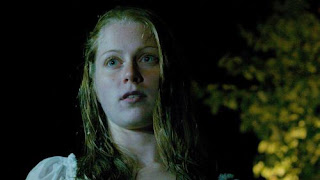Text © Richard Gary / Indie Horror Films, 2020
Images from the Internet
The Bone Box
Directed by Luke Genton
LakeShore Productions; Terror Films
87 minutes, 2020
There was a time when grave robbing was a
profession, much like burglary. Sometimes they would steal the body (look up
Burke and Hare), others it was the contents of the graves (such as jewelry). It
doesn’t really happen much these days, but this film sheds a light on that very
crime.
 |
| Gareth Koorzen and Maria Olsen |
We are introduced to Tom (Gareth Koorzen). He is
recently mourning his wife, but also he drinks too much, and gambles through
his depression. What better reason to snatch some gems from the deceased as he
is mad at death for taking his partner, Claire (Tess Bellomo). Currently he is
living with his Aunt Florence (the wonderful Maria Olsen), who is also recently
bereaving her husband – and just happens to live next door to the cemetery. As
Dana Carvey might say, “How convenient!”
Working with Elodie (Michelle Krusiec, who was
a semi-regular on shows like “Hawaii Five-O” and “General Hospital”), the daughter
of the funeral parlor director to get the list of recent burials, Tom spends a
night digging away to sell the bling to pawn shops. This is all to pay off a
large gambling debt to a bookie named Benji (a cameo by Aaron Schwartz, who’s danced
around the big leagues with credits including “Gossip Girl” and his first film,
1992’s The Mighty Ducks).
Tom comes across as cold-hearted and uncaring
about his night activity, but other things are going on around him in the house
that are starting to unnerve him. Florence has a long speech about how objects
become more than what they are as they become memories, and this translates
into Tom seeing glances of the deceased he stole from roaming around the house.
Is it “real,” his deep-seated guilt, or Memorex? (Sorry…). If so, this could
be seen as a direct descendant of Poe’s short story, “The Tell-Tale Heart.” But
is it?
We see the spirits (or imagined ones) popping
in and out in shadows, backgrounds and eye corners. The way
they just appear is well done, sliding through the viewer’s vision, and then poof.
One of the ways this is indicated is by a changing painting, drawn by Tom’s
late uncle (who’s grave he also pilfered). Each time he looks, a shadowy figure
is slowly making it’s way to the front door, a theme also effectively used in a
similar fashion in the pilot episode of the television show “Night Gallery” (1969),
in a segment titled “The Cemetery” (with Ossie Davis and Roddy McDowell).
 |
| Michelle Krusiec |
Most of the film takes place within the house
(after the opening), but the director helps keep it from getting too claustrophobic
by some really smart camera work by cinematographer Gonzalo Digenio. There is
very little editing within the scenes, and by using a handheld, the camera
moves around the actors as they talk, giving some feeling of the viewer’s own presence
in the scene. It’s not overly shaky like found footage, so the motion sickness feeling
is not present, but with the lack of editing, this gives the dialogue and the actors
themselves a chance to carry the scenes rather than rely on editing for action
(Sergei Eisenstein discussed this about 100 years ago).
This ain’t no Poltergeist (1982), where
the ghosts are heavily interacting with the living, like shoving Carol Ann
across the kitchen floor; this is more subtle, which is also a nice touch. The motive
for the spirits’ actions, if they in fact exist, is also revenge, however. This
is the first film for director Luke Genton, and he makes the most of it by
keeping it small and tight, without making it feel too cramped. Really nice
first effort.
Tom is a bit of a dick in that he has let his
emotions and addictions get the better of him through his grief, and Koorzen
plays him well, giving the viewer a chance to still care about him. His Afrikaner
accent is a bit distracting for about a minute, but when you add in Olsen’s
similar natural inflection, it actually works – though I would have liked some explanation
about that, unless I missed it. Everyone bodes well in the acting area,
managing sometimes large amounts of dialogue in particular scenes.
This is a kind of film that would be mostly
okay to show to newbies to the genre, as there is very little blood, a small
body count per se, and only one or two bits which could be considered squeamish.
There is also no nudity or much in the way of cussin’, either. This is more of a
personality-driven story, rather than shock, even with ghosts popping in and
out here and there throughout. It is quite entertaining.






















